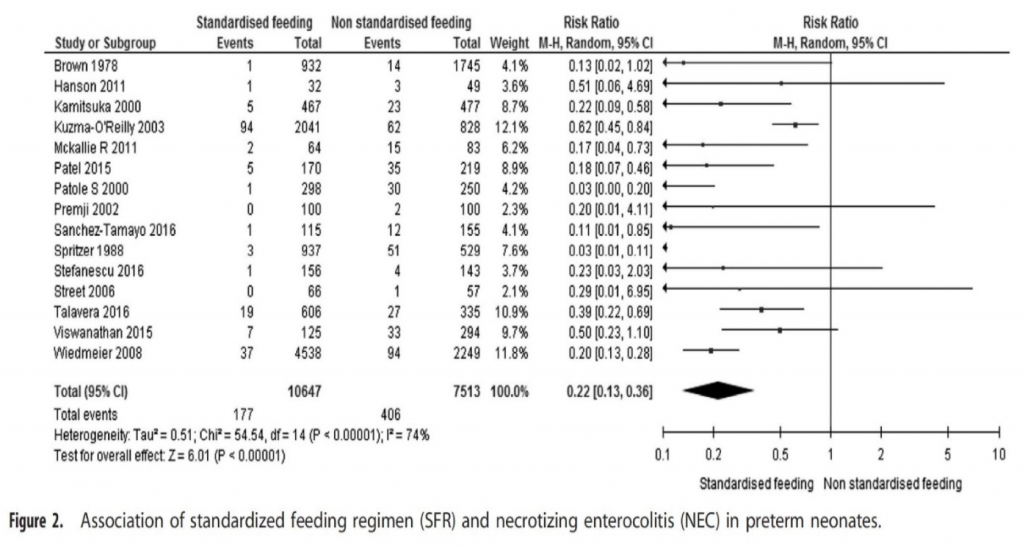Standardized Feeding Protocols Reduce Risk of NEC

Many NICUs have developed a feeding guideline / protocol / pathway to advance enteral nutrition in a consistent manner for the preterm neonates in their care. These relatively simple QI tools have been shown to reduce the risk of necrotizing enterocolitis (NEC) > stage II. In 2005, a systematic review and meta-analysis of observational studies reporting the use of standardized feeding regimens or protocols was published and reported up to an 87% reduction in incidence of NEC.1
The latest publication is another systematic review to include additional observation studies conducted on the incidence of NEC utilizing a standardized feeding advancement since the original publication in 2005.2 The results of the review are copied below in the forest plot figure from the publication were it was demonstrated there was significant benefit for NEC reduction with the use of a feeding guideline.2

Development of a standardized approach to enteral volume advancement is an important QI strategy to reduce practice variation and reduce risk of NEC. There are many examples of these tools published in the literature. These tools vary greatly between NICUs and there is no one “best” Feeding Protocol. Each unit should develop their protocol and process based upon the evidence, their unique unit context and an agreement of consensus amongst the interdisciplinary team.
Consider a few questions to evaluate your NICU practice:
- If your NICU does not utilize a standardized feeding advancement tool (guideline, protocol, or pathway), can you gather an interdisciplinary team, review the evidence and implement a tool to reduce the incidence of NEC?
- If your NICU utilizes a standardized feeding advancement tool:
a. Is it being implemented reliably for all eligible neonates? (Meaning are you monitoring reliable use of the tool– what are outliers [provider or patient])
b. Is the protocol being reviewed periodically for needed updates? (Changes based on new evidence, or NICU culture change)
c. Are there opportunities to include additional standardizing processes within the guideline? (Addition of fortifiers, removal of central lines, etc.)
1 Patole, S. K., and N. De Klerk. “Impact of standardised feeding regimens on incidence of neonatal necrotising enterocolitis: a systematic review and meta-analysis of observational studies.” Archives of Disease in Childhood-Fetal and Neonatal Edition 90.2 (2005): F147-F151. https://fn.bmj.com/content/90/2/F147.short
2 Jasani, B., and S. Patole. “Standardized feeding regimen for reducing necrotizing enterocolitis in preterm infants: an updated systematic review.” Journal of Perinatology 37.7 (2017): 827.
To read more, access the article from Journal of Perinatology via Research Gate at:
https://preview.tinyurl.com/y96jxeay[/fusion_text][/fusion_builder_column][/fusion_builder_row][/fusion_builder_container]



